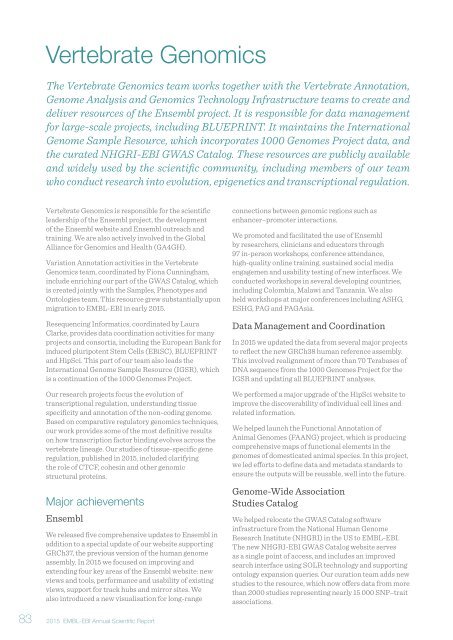Annual Scientific Report 2015
EMBL_EBI_ASR_2015_DigitalEdition
EMBL_EBI_ASR_2015_DigitalEdition
You also want an ePaper? Increase the reach of your titles
YUMPU automatically turns print PDFs into web optimized ePapers that Google loves.
Vertebrate Genomics<br />
The Vertebrate Genomics team works together with the Vertebrate Annotation,<br />
Genome Analysis and Genomics Technology Infrastructure teams to create and<br />
deliver resources of the Ensembl project. It is responsible for data management<br />
for large-scale projects, including BLUEPRINT. It maintains the International<br />
Genome Sample Resource, which incorporates 1000 Genomes Project data, and<br />
the curated NHGRI-EBI GWAS Catalog. These resources are publicly available<br />
and widely used by the scientific community, including members of our team<br />
who conduct research into evolution, epigenetics and transcriptional regulation.<br />
83<br />
Vertebrate Genomics is responsible for the scientific<br />
leadership of the Ensembl project, the development<br />
of the Ensembl website and Ensembl outreach and<br />
training. We are also actively involved in the Global<br />
Alliance for Genomics and Health (GA4GH).<br />
Variation Annotation activities in the Vertebrate<br />
Genomics team, coordinated by Fiona Cunningham,<br />
include enriching our part of the GWAS Catalog, which<br />
is created jointly with the Samples, Phenotypes and<br />
Ontologies team. This resource grew substantially upon<br />
migration to EMBL-EBI in early <strong>2015</strong>.<br />
Resequencing Informatics, coordinated by Laura<br />
Clarke, provides data coordination activities for many<br />
projects and consortia, including the European Bank for<br />
induced pluripotent Stem Cells (EBiSC), BLUEPRINT<br />
and HipSci. This part of our team also leads the<br />
International Genome Sample Resource (IGSR), which<br />
is a continuation of the 1000 Genomes Project.<br />
Our research projects focus the evolution of<br />
transcriptional regulation, understanding tissue<br />
specificity and annotation of the non-coding genome.<br />
Based on comparative regulatory genomics techniques,<br />
our work provides some of the most definitive results<br />
on how transcription factor binding evolves across the<br />
vertebrate lineage. Our studies of tissue-specific gene<br />
regulation, published in <strong>2015</strong>, included clarifying<br />
the role of CTCF, cohesin and other genomic<br />
structural proteins.<br />
Major achievements<br />
Ensembl<br />
We released five comprehensive updates to Ensembl in<br />
addition to a special update of our website supporting<br />
GRCh37, the previous version of the human genome<br />
assembly. In <strong>2015</strong> we focused on improving and<br />
extending four key areas of the Ensembl website: new<br />
views and tools, performance and usability of existing<br />
views, support for track hubs and mirror sites. We<br />
also introduced a new visualisation for long-range<br />
<strong>2015</strong> EMBL-EBI <strong>Annual</strong> <strong>Scientific</strong> <strong>Report</strong><br />
connections between genomic regions such as<br />
enhancer–promoter interactions.<br />
We promoted and facilitated the use of Ensembl<br />
by researchers, clinicians and educators through<br />
97 in-person workshops, conference attendance,<br />
high-quality online training, sustained social media<br />
engagemen and usability testing of new interfaces. We<br />
conducted workshops in several developing countries,<br />
including Colombia, Malawi and Tanzania. We also<br />
held workshops at major conferences including ASHG,<br />
ESHG, PAG and PAGAsia.<br />
Data Management and Coordination<br />
In <strong>2015</strong> we updated the data from several major projects<br />
to reflect the new GRCh38 human reference assembly.<br />
This involved realignment of more than 70 Terabases of<br />
DNA sequence from the 1000 Genomes Project for the<br />
IGSR and updating all BLUEPRINT analyses.<br />
We performed a major upgrade of the HipSci website to<br />
improve the discoverability of individual cell lines and<br />
related information.<br />
We helped launch the Functional Annotation of<br />
Animal Genomes (FAANG) project, which is producing<br />
comprehensive maps of functional elements in the<br />
genomes of domesticated animal species. In this project,<br />
we led efforts to define data and metadata standards to<br />
ensure the outputs will be reusable, well into the future.<br />
Genome-Wide Association<br />
Studies Catalog<br />
We helped relocate the GWAS Catalog software<br />
infrastructure from the National Human Genome<br />
Research Institute (NHGRI) in the US to EMBL-EBI.<br />
The new NHGRI-EBI GWAS Catalog website serves<br />
as a single point of access, and includes an improved<br />
search interface using SOLR technology and supporting<br />
ontology expansion queries. Our curation team adds new<br />
studies to the resource, which now offers data from more<br />
than 2000 studies representing nearly 15 000 SNP–trait<br />
associations.


